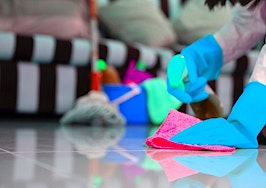For the past six months, the coronavirus has pushed Americans to clean more than ever before, as evidenced by purchase limits on sanitizer and other household cleaning products.
Although the extra hours spent repeatedly cleaning doorknobs, tables and toilets have taken a physical and financial toll on the everyday person, it pales in comparison to property owners who face the greater challenge of keeping tenants and employees safe in their residential or commercial buildings.
“Now, more than ever before, property managers and owners have a huge responsibility resting on their shoulders — that is, to keep occupants safe,” a recent Propmodo article states. “But in this case, there is no handbook or roadmap that’s been clearly established for best practices.”
“Everyone is essentially writing their own, and unfortunately, this lack of clarity is trickling down to every level of property management, including those responsible for allocating custodial and cleaning resources,” it continued.
While some property owners are investing in additional cleaning crews and resources, others are relying on an emerging trend called predictive cleaning. Much like its predecessor predictive maintenance, predictive cleaning relies on sensor technology to help owners and managers identify high-traffic, low-traffic and no-traffic areas so they can properly restructure cleaning procedures.

Microshare COO Tom Jackson
Microshare Chief Operating Officer Tom Jackson said COVID has brought more attention to his company, with property owners around the world asking for Microshare’s predictive cleaning and contact tracing solutions that rely on sensors.
“[Predictive cleaning] has primarily been for the commercial real estate market and larger landlords,” Jackson said. “When COVID hit, we tweaked [our asset tracing] solution for hospitals to make it available for contact tracing.”
“That actually has us quite busy all around the world,” he added. “We have a number of [projects] that we’re doing in Asia, Australia, the United States and Europe.”
Microshare’s predictive cleaning solution relies on thousands of sensors that are installed above doors and other entryways in a building. Someone from Microshare’s team or a third-party company will install and label the sensors, which Jackson said are a third of the size of a dollar bill.
From there, the sensors will send data to Microshare’s business intelligence platform that allows managers to create a cleaning schedule that prioritizes areas based on traffic.
“Generally in large commercial spaces, the cleaning staff is on a fixed schedule and they follow a route that is spacially oriented,” Jackson explained. “When we put our sensors in to measure the utilization of the space, they are in a position to understand that areas that they normally go in to tidy up, don’t need to be cleaned because no one has used them.”
“People discover they haven’t made the best use of their cleaning resources historically because, for the last 50 years, people have cleaned [commercial buildings] based on spatial orientation, not a demand orientation,” Jackson added. “Now they have the ability to do extra COVID cleaning without increasing their spending.”
“[COVID cleaning] could equal 10 to 30 percent of the overall hours they’ve allocated to cleaning, and now they don’t have to get additional cleaners to do that.”
Jackson said predictive cleaning has yet to gain steam in the residential space, but he sees the use for it in larger, multi-family developments with common spaces and shared amenities.
“I think it would be useful more for larger buildings than smaller buildings,” he said. “The common areas would make sense, specifically the laundry room.”
“Larger multi-family situations have exercise rooms and other amenities that are more closed off that would allow for space monitoring,” he added. “The reason it’s effective both in healthcare and in a commercial setting is because we’re monitoring desk and office utilization and restrooms, and that could be true in a multi-family situation as well.”
Although Microshare isn’t suited for smaller properties, there are solutions for small-time investors who want to ensure tenants and guests are safe in their homes. Breezeway, a property management platform that clinched $8 million in funding on Tuesday, offers predictive task management so owners can keep track of cleaning and maintenance.
“Safety is the biggest trend in travel right now, as COVID-19 means you have to be more detail-oriented about protocol,” Breezeway CEO Jeremy Gall said in a previous Inman article. “We are providing property managers with the tools to drive efficiency, get the right person to do the job at the right time and validating, for us, clients can get more done with less people.”
Unlike Microshare, which relies on sensor technology, Breezeway helps property managers streamline cleaning services through a platform that provides real-time insights on which properties need specific cleaning services, how quickly services are being done, and mobile checklists to make sure everything is up to par.
“The way we interact with the built world is changing, and expectations for how space is prepared are higher than ever,” Gall said in a separate interview with Pulse 2.0. “This trend has been accelerating for recent years across multiple property segments from commercial offices, retail stores, hospitality, and especially residential property.”
For property owners who want to take a DIY approach, HomeAdvisor Smart Home Strategist Dan DiClerico said predictive cleaning is gaining traction in the consumer space as well.

Dan DiClerico
“It really is emerging, so it is a great trend piece because it’s leading edge,” DiClerico told Inman. “I do really believe it comes out of predictive maintenance, which we’ve talked about before.”
“Maintenance is usually reactive — your furnace or refrigerator breaks and you get it repaired. With advanced sensor technology, homeowners can get that ‘check engine’ light for the home,” he added. “It’s the same idea with predictive cleaning where sensor technology is used to monitor the levels of cleanliness throughout the home, so rooms are cleaned on an as-needed basis rather than according to a fixed schedule.”
“It builds a lot of efficiencies because you’re not cleaning spaces that don’t need to be cleaned, so you’re able to save on labor and material costs,” he continued.
DiClerico said property owners can install sensor technology in trash cans in a common area or on a toilet paper dispenser in a public restroom that will alert their cleaning team when something needs to be replaced.
“Again, it’s all about creating these efficiencies so you’re not spending time on tasks that aren’t ready to be done or don’t need to be done,” he said. “I think robotics is another part of predictive cleaning, and I think the best example is robotic vacuums.”
“They’ve been around for a long time, but thanks to artificial intelligence and sensor technology, they’re getting more sophisticated to the point where they can self-deploy when dirt and dust levels reach certain levels,” he added. “I don’t think it will be long before robots are used to clean any surface.”
No matter what solution a property owner chooses to use, DiClerico said there will be a “significant up-front investment,” but the return on time, labor and materials will come quickly.
Looking forward, Jackson and DiClerico said the reliance on predictive cleaning and maintenance will only grow stronger, as the world works to adjust to a new normal.
“This problem didn’t exist [six] months ago because there was no COVID situation here or in Europe, and now its a global issue,” Jackson said. “The fundamental thing that needs to be done is that people have to rethink how cleaning is done.”
“That’s a fairly large switch for organizations to make,” he said of the move toward predictive cleaning. “It’s easy to understand [the benefits], but they don’t have detailed information to let them know how spaces are used and execute it.”













